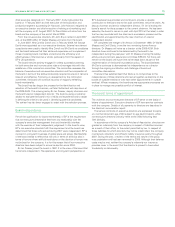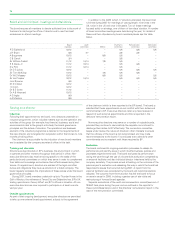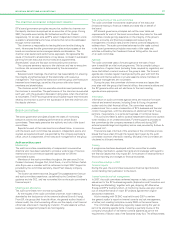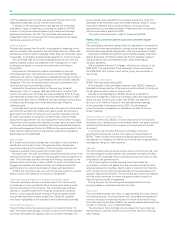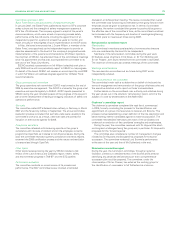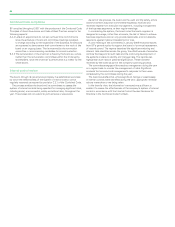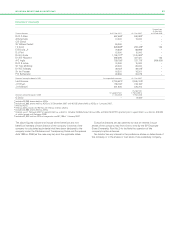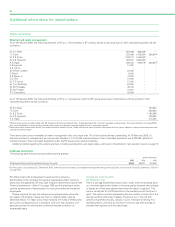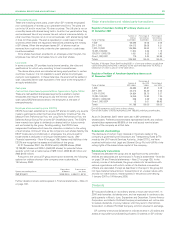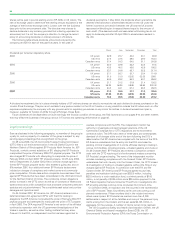BP 2007 Annual Report Download - page 87
Download and view the complete annual report
Please find page 87 of the 2007 BP annual report below. You can navigate through the pages in the report by either clicking on the pages listed below, or by using the keyword search tool below to find specific information within the annual report.
Environmental Quality (TCEQ) and the DOJ, among other agencies, have
conducted or are conducting investigations. At the conclusion of their
investigation, OSHA issued citations that BP Products agreed not to
contest. BP Products settled that matter with OSHA on 22 September
2005, paying a $21.4 million penalty and undertaking a number of
corrective actions designed to make the refinery safer.
In June 2006, BP Products and the TCEQ entered into an agreed order
resolving a number of alleged violations and, among other things,
authorizing the refinery to construct certain new flares needed to replace
blowdown stacks. In addition, BP Products agreed to pay a $336,556 civil
penalty.
At the recommendation of the CSB, BP appointed an independent
safety panel, the BP US Refineries Independent Safety Review Panel,
under the chairmanship of former US Secretary of State James A Baker,
III. See Report of the BP US Refineries Safety Review Panel on page 28
for a discussion of the panel’s report, which was published on 16 January
2007.
In March 2007, the CSB issued its final report, which contained
recommendations to the Texas City refinery and to the board of the
company. In May 2007, BP responded to the CSB’s recommendations.
BP and the CSB continue to discuss BP’s responses with the objective
of the CSB agreeing to close-out its recommendations.
On 25 October 2007, the DOJ announced that it had entered into a
criminal plea agreement with BP Products related to the March 2005
explosion and fire. On 4 February 2008, BP Products pleaded guilty in
federal court, pursuant to the plea agreement, to one felony violation of
the risk management planning regulations promulgated under the US
federal Clean Air Act. At the plea hearing the court advised that it would
take the matter under review and decide whether to accept or reject
the plea. If the court accepts the agreement, BP Products will pay a
$50 million criminal fine and serve three years’ probation. Compliance
with the 2005 OSHA settlement agreement and the 2006 TCEQ Agreed
Order are conditions of probation.
On 2 March 2006, a crude oil leak of approximately 4,800 barrels
occurred on a low-pressure transit line on the Alaskan North Slope in
the Western Operating Area of the Prudhoe Bay field operated by BP
Exploration (Alaska) Inc. (BPXA). The March 2006 leak was determined to
be the result of internal corrosion. On 6 August 2006, BPXA ordered a
phased shutdown of the Prudhoe Bay oil field following the discovery of
unexpectedly severe internal corrosion and a leak of 199 barrels of crude
oil from the oil transit line in the Eastern Operating Area of Prudhoe Bay.
Shortly after the March 2006 leak, the DOJ initiated an investigation of
the spill through a federal grand jury in Alaska. During the course of the
following 17 months, BPXA co-operated with the US government’s
investigation, including among other things, by producing millions of
pages of documents, encouraging its employees to co-operate with the
investigation and provide testimony to the grand jury, and by providing
the government’s investigators with samples from and sections of the
segment of the failed transit line.
On 25 October 2007, BPXA entered into an agreement with the DOJ
in which it agreed to plead guilty to one US Federal Water Pollution
Control Act misdemeanour violation relating to the March 2006 crude oil
leak. The plea agreement resolved all of the federal and State of Alaska
criminal culpability of BPXA associated with the March and August leaks
at Prudhoe Bay. On 29 November 2007, the US District Court for the
District of Alaska accepted the plea agreement, entered a misdemeanour
guilty plea against BPXA and sentenced BPXA to pay a combined
$20 million in criminal fines, restitution and community service payments
and serve three years’ of probation. BPXA has the right to petition the
court for termination of the probation term after one year if it meets
certain benchmarks relating to replacement of the transit lines, upgrades
to its leak detection system and improvements to its integrity
management programme. All criminal fines and other payments required
by the plea agreement and sentence were made by BPXA on the date of
sentencing following entry of the plea.
BPXA continues to co-operate with a parallel State of Alaska civil
investigation into the March and August 2006 spills, including three
separate subpoenas issued to BPXA by the Alaska Department of
Environmental Conservation. BPXA is also engaged in discussions with
the DOJ, the EPA and the US Department of Transport concerning civil
regulatory claims relating to the 2006 Prudhoe Bay oil transit line
incidents.
Shareholder derivative lawsuits have been filed in US federal and state
courts against the directors of the company and others, nominally the
company and certain US subsidiaries following the events relating to,
inter alia, Prudhoe Bay, Texas City and the trading cases, alleging breach
of fiduciary duty. These derivative lawsuits have been settled, subject to
court approval.
Approximately 200 lawsuits were filed in state and federal courts in
Alaska seeking compensatory and punitive damages arising out of the
Exxon Valdez oil spill in Prince William Sound in March 1989. Most of
those suits named Exxon (now ExxonMobil), Alyeska Pipeline Service
Company (Alyeska), which operates the oil terminal at Valdez, and the
other oil companies that own Alyeska. Alyeska initially responded to the
spill until the response was taken over by Exxon. BP owns a 47%
interest (reduced during 2001 from 50% by a sale of 3% to Phillips) in
Alyeska through a subsidiary of BP America Inc. and briefly indirectly
owned a further 20% interest in Alyeska following BP’s combination with
Atlantic Richfield. Alyeska and its owners have settled all the claims
against them under these lawsuits. Exxon has indicated that it may file
a claim for contribution against Alyeska for a portion of the costs and
damages that it has incurred. If any claims are asserted by Exxon that
affect Alyeska and its owners, BP will defend the claims vigorously.
Since 1987, Atlantic Richfield, a subsidiary of BP, has been named as
a co-defendant in numerous lawsuits brought in the US alleging injury to
persons and property caused by lead pigment in paint. The majority of
the lawsuits have been abandoned or dismissed against Atlantic
Richfield. Atlantic Richfield is named in these lawsuits as alleged
successor to International Smelting and Refining, which, along with a
predecessor company, manufactured lead pigment during the period
1920-1946. Plaintiffs include individuals and governmental entities.
Several of the lawsuits purport to be class actions. The lawsuits seek
various remedies including compensation to lead-poisoned children, cost
to find and remove lead paint from buildings, medical monitoring and
screening programmes, public warning and education of lead hazards,
reimbursement of government healthcare costs and special education for
lead-poisoned citizens and punitive damages. No lawsuit against Atlantic
Richfield has been settled nor has Atlantic Richfield been subject to a
final adverse judgment in any proceeding. The amounts claimed and, if
such suits were successful, the costs of implementing the remedies
sought in the various cases could be substantial. While it is not possible
to predict the outcome of these legal actions, Atlantic Richfield believes
that it has valid defences and it intends to defend such actions vigorously
and that the incurrence of liability is remote. Consequently, BP believes
that the impact of these lawsuits on the group’s results of operations,
financial position or liquidity will not be material.
For certain information regarding environmental proceedings, see
Environmental protection – US regional review on page 43.
The offer and listing
Markets and market prices
The primary market for BP’s ordinary shares is the London Stock
Exchange (LSE). BP’s ordinary shares are a constituent element of the
Financial Times Stock Exchange 100 Index. BP’s ordinary shares are also
traded on stock exchanges in France, Germany, Japan and Switzerland.
Trading of BP’s shares on the LSE is primarily through the use of the
Stock Exchange Electronic Trading Service (SETS), introduced in 1997 for
the largest companies in terms of market capitalization whose primary
listing is the LSE. Under SETS, buy and sell orders at specific prices may
be sent to the exchange electronically by any firm that is a member of
the LSE, on behalf of a client or on behalf of itself acting as a principal.
The orders are then anonymously displayed in the order book. When
there is a match on a buy and a sell order, the trade is executed and
automatically reported to the LSE. Trading is continuous from 8.00 a.m.
to 4.30 p.m. UK time but, in the event of a 20% movement in the share
price either way, the LSE may impose a temporary halt in the trading of
BP ANNUAL REPORT AND ACCOUNTS 2007 85


